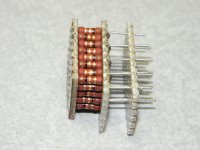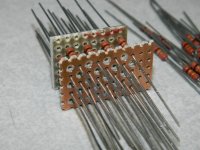The message that I am getting is that I expose myself to criticism by bringing up taboo topics or individuals, even if I have experience and acquaintance with them, as if this was some sort of 'politically correct' thread.
The message being sent to you is different.
And that message is....we are not stupid. Incredible claims require incredible proof.
Not name dropping in lieu of.
jn
This sort of academic behavior happens a lot. And it is shameful. What I find is that reputations count the most, and they are most frequently based on a chain of evaluations, with the particular person under consideration at at least a few degrees of separation from the person making the judgments.The message that I am getting is that I expose myself to criticism by bringing up taboo topics or individuals, even if I have experience and acquaintance with them, as if this was some sort of 'politically correct' thread.
If I am allowed, I would like to bring up another 'story' that happened back in 1978, or 35 years ago, at an IEEE conference on Audio and Electroacoustics.
I was talking with Walt Jung, who was also giving a paper there, when we happened on the professor who had rejected Walt's original SID paper for submission into the JAES.
I was standing next to Walt when he asked the professor (AES referee) what was wrong with the paper that was coauthored by two other engineers as well as Walt. The professor said that he 'didn't like the math' pointing to a section where one of the other engineers had added something on the Volterra Series, and this professor didn't like it, BUT he could not tell us why.
Now, it just happens that I took a class at UCB with the same engineer who put the Volterra Series section in the paper and I learned it from the same professor at the same time as he did. Now, maybe, of course, the other engineer 'might' have gotten the math wrong, how would I know for sure? Well, just this week I got a paper on the Volterra Series coauthored by both RG Meyer and this other engineer, perhaps as his masters thesis. I now know that this other engineer knew what he was doing, far more than I could ever do, because he had worked with Dr. Meyer to a much greater extent with the Volterra Series than we ever learned in class. Therefore the 'professor' who rejected the paper, was full of it, and if he had any real evidence against the 'math' he should have PROVEN IT in writing, and not just by fiat, before rejecting the SID paper.
What happened then? Both of the other engineers contributing to the SID paper, DROPPED OUT, scared of being tarnished by being associated with SID.
Walt had to publish it in 'The Audio Amateur' or TAA alone, and the other two ran like scared chickens! I guess that is what I am supposed to do with 'advanced or controversial' material. Well, I won't be deterred from giving information as I see it.
And the old equivalencies hold: one mistaken thing negates a thousand correct. Since innovation is always harder to assess (it's necessarily new to some extent) it carries a higher risk of error. And referees are often lazy. However the better journals give the author(s) a chance to respond, unless the material is just so wacky or obviously flawed that it's not even considered.
Also an advanced degree is to some extent a prerequisite for being taken seriously, even though a PhD, besides indication of expertise in a relatively narrow subfield, is merely evidence of having some broad knowledge of the field sufficient to get through a final oral exam and preceding comprehensives. It cannot really be much more than that given the incredible amount of material in any discipline today. And yet the possessors are frequently viewed as omniscient and infallible, and some fall prey to this delusion --- note how often a PhD let alone a professor is willing to simply state "I don't know".
It has been conjectured that Einstein's papers beginning in 1905 would probably be rejected if submitted in the same review climate as today, so revolutionary were they at the time.
However, against this one must be aware of the numbers of totally off-the-wall speculative things that are riddled with internal contradictions and sloppy-to-nonexistent maths, and often accompanied by an underlying resentment of The System and an accompanying sense of martyrdom. That some review process is needed is indisputable.
Walt had to publish it in 'The Audio Amateur' or TAA alone, and the other two ran like scared chickens! I guess that is what I am supposed to do with 'advanced or controversial' material. Well, I won't be deterred from giving information as I see it.
The AD797 was rejected as a full JAES paper, probably threatened the hegemony.
Well, Toes
A solid core copper wire with insulation that's pinched or shock-pulled can go discontinuous.
Still looks OK on the outside, but as useful as a fully cut wire.
Nerves are also insulation sleeved, and show simular behavior.
Difference is that a nerve is self-repairing, sort of an ivy branch in an elastic tube.
If discontinuous, but with sleeving still intact, the nerve grows back in till it hits the connection nodes, growth rate is ~0.04-0.08"/day.
Temperature sensitivity is an indication of the repair job score.
With the sleeving also disrupted, the ivy goes everywhere, but no making whoopie.
(not merely book-keeper reading, practical experience as well. Happened to my leg, from full paralysis on crutches and electric-wheelchair racing in the supermarket, till wiggling all my toes took about a year)
50 bucks, 87.50 for a 2nd opinion consultation fee.
Last edited:
Brad, you also assume that the story is being recounted accurately. It may be, but without details, it's difficult to tell.
Not around my house, no.
See Jeremy Bernstein's superb essay on this very topic.
And yet the possessors are frequently viewed as omniscient and infallible
Not around my house, no.
It has been conjectured that Einstein's papers beginning in 1905 would probably be rejected if submitted in the same review climate as today, so revolutionary were they at the time.
See Jeremy Bernstein's superb essay on this very topic.
John does not want the respect of his peers (because he is so far above), he wants a court of believers.And that message is....we are not stupid. Incredible claims require incredible proof.
He regularly descends from his cloud to test our faith.
Last edited:
A solid core copper wire with insulation that's pinched or shock-pulled can go discontinuous.
Still looks OK on the outside, but as useful as a fully cut wire.
Nerves are also insulation sleeved, and show simular behavior.
Difference is that a nerve is self-repairing, sort of an ivy branch in an elastic tube.
If discontinuous, but with sleeving still intact, the nerve grows back in till it hits the connection nodes, growth rate is ~0.04-0.08"/day.
Temperature sensitivity is an indication of the repair job score.
With the sleeving also disrupted, the ivy goes everywhere, but no making whoopie.
(not merely book-keeper reading, practical experience as well. Happened to my leg, from full paralysis on crutches and electric-wheelchair racing in the supermarket, till wiggling all my toes took about a year)
50 bucks, 87.50 for a 2nd opinion consultation fee.
DA#M...I thought you were joking.
I didn't notice any temperature sensitivity. Just more of a stiffness. I guess I just have a low threshold for pain..well, that's what my wife tells me...
$50? worth it.. wanna barter?
need any clock gears or low impedance cables?? or maybe a 100 millliohm current viewing resistor with about 200 picohenries of inductance??
edit: 87.50 for second opinion..ya gonna tell me I'm ugly too??
jn
Attachments
Last edited:
See Jeremy Bernstein's superb essay on this very topic.
I'll hunt that down. Maybe I even saw it, if it was a good deal of time ago.
I'm reminded as well of the physics folks, was it Nernst in particular, who told an already-reluctant Max Planck that he could achieve the same fix for the "ultraviolet catastrophe" with arrangements of connecting pipes and such.
Einstein had a great deal of contempt for his fellow physicists. The image portrayed until relatively recently of the quietly timid and diffident patent examiner was apparently far off the mark.
Considering how poorly he played at politics, it's all the more remarkable that he got published, even in those times.
http://www.capatcolumbia.com/reading packet/Einstein Crank.pdf
I'll save you a few clicks.
These days, there's always ArXiv.
I'll save you a few clicks.
These days, there's always ArXiv.
Politics is the ability to tell two opposing views to two groups and appear to be telling the truth to both while believing neither.
Science is being able to tell all groups the same information while believing all of it even in the face of 100% disbelief by everyone. But in science we have information to back up our claims and can sway the disbelievers with a convincing argument and facts.
Science is being able to tell all groups the same information while believing all of it even in the face of 100% disbelief by everyone. But in science we have information to back up our claims and can sway the disbelievers with a convincing argument and facts.
If you're doing any museum quality restoration these folks have many hard to find things.
Dyes - Kremer Pigments Inc.
Whoa. I've absolutely no idea what I was looking at there. I was looking in Klingspor's catalog, thinkin maybe "dark brown" or "ebony"...Kremer goes through all them chemical sounding names, I've no clue what they are..
29th street near 7th...sheesh, I'm gonna be at 1st and 72nd tomorrow...so close but yet so far..
I'll tell the museum people about that site, they may be able to use some of the stuff.
thanks again.
John
John,
Of course it is not a level playing field. We have amateurs such as myself on the electronic side and professionals that have experience far beyond audio electronics. It is always hard to have a conversation in that regards. It would be like me sitting in on a class on nuclear physics, I would not be able to contribute to the conversation or understand what is said. It is when someone like that starts to argue about something they know nothing about when it is really silly. But fill a room with like minded or educated minds and you will still get much disagreement on any subject. I am not that naive, just more pragmatic in how I look at something and willing to say I don't know.
Of course it is not a level playing field. We have amateurs such as myself on the electronic side and professionals that have experience far beyond audio electronics. It is always hard to have a conversation in that regards. It would be like me sitting in on a class on nuclear physics, I would not be able to contribute to the conversation or understand what is said. It is when someone like that starts to argue about something they know nothing about when it is really silly. But fill a room with like minded or educated minds and you will still get much disagreement on any subject. I am not that naive, just more pragmatic in how I look at something and willing to say I don't know.
Thanks---ah yes I have that book, must have at least skimmed that chapterhttp://www.capatcolumbia.com/reading packet/Einstein Crank.pdf
I'll save you a few clicks.
These days, there's always ArXiv.
Well back to audio.
Attached is my 50 ohm load from a CT 24V transformer. I used four 4700 uF capacitors and three 1 ohm resistors. It went from all the capacitors in parallel to a four stage CRCRCRC filter. As a CRCRC filter it did not seem to matter where the 9400 uF was positioned. Of course the four stage filter was the best. Total voltage loss was 6%. So the conclusion seems to be calculated what the worst case into the filter will be and the minimum you need out of it and use a three or four stage filter that uses up the voltage.
ES
Attached is my 50 ohm load from a CT 24V transformer. I used four 4700 uF capacitors and three 1 ohm resistors. It went from all the capacitors in parallel to a four stage CRCRCRC filter. As a CRCRC filter it did not seem to matter where the 9400 uF was positioned. Of course the four stage filter was the best. Total voltage loss was 6%. So the conclusion seems to be calculated what the worst case into the filter will be and the minimum you need out of it and use a three or four stage filter that uses up the voltage.
ES
Attachments
Who
I'll tell the museum people about that site, they may be able to use some of the stuff.
thanks again.
John
You should see my mineral color set from China, the names are all in Chinese with colloquial names for the colors, "big red", "star blue". At least you can be sure the vermilion is mercuric sulfide.
You should see my mineral color set from China, the names are all in Chinese with colloquial names for the colors, "big red", "star blue". At least you can be sure the vermilion is mercuric sulfide.
Sounds dangerous to me. Looks like I'm gonna need a chemist to explain all these compounds to me so I don't kill mself.
Where the heck am I gonna find a chemist around here???
specially an OLD one..
jn
ps..my favorite beverage name in Beijing was "40 degree"
Last edited:
- Status
- Not open for further replies.
- Home
- Member Areas
- The Lounge
- John Curl's Blowtorch preamplifier part II


